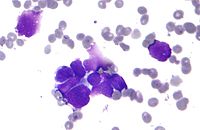
Photo from wikipedia
Purpose Patients with gastrointestinal neuroendocrine carcinoma (GI-NEC) have poor prognoses. Although platinum-based combination chemotherapy is commonly used as first-line treatment, the benefit of amrubicin (AMR) and salvage chemotherapy in those… Click to show full abstract
Purpose Patients with gastrointestinal neuroendocrine carcinoma (GI-NEC) have poor prognoses. Although platinum-based combination chemotherapy is commonly used as first-line treatment, the benefit of amrubicin (AMR) and salvage chemotherapy in those who develop platinum-refractory GI-NEC remains unknown. This study aimed to evaluate the efficacy and safety of AMR monotherapy in patients with platinum-refractory GI-NEC. Patients and methods Platinum-refractory GI-NEC patients who received AMR monotherapy between April 2012 and September 2017 were retrospectively analyzed. The overall response rate (ORR), progression-free survival (PFS), overall survival (OS), and adverse events were evaluated. PFS and OS were estimated using Kaplan-Meier methods and compared using log-rank tests. Results In total, 16 patients were enrolled. Of them, 13 (81.3%), 1 (6.2%), and 2 (12.5%) received cisplatin plus irinotecan, cisplatin plus etoposide, and fluoropyrimidine plus platinum, respectively, before AMR monotherapy. The primary sites of NEC included the esophagus (N=3, 18.8%), stomach (N=10, 62.5%), duodenum (N=1, 6.2%) and colorectum (N=2, 12.5%). Patients were administered a median of 3 (range, 1–15) cycles of AMR. The ORR was 6.3%, and the median PFS and OS were 2.9 months (95% CI: 1.7–7.4) and 13.8 months (95% CI: 7.9–23.5), respectively. Neutropenia was the most serious adverse event. Grade 3 or higher neutropenia and febrile neutropenia occurred in 50.0% and 6.2% of patients, respectively. Other nonhematological toxicities were not severe, and no treatment-related deaths occurred. The 10 patients who received subsequent chemotherapy after AMR had significantly longer OS than those who did not (17.3 months vs 8.9 months; p=0.018). The median PFS of those who received organ-specific subsequent chemotherapy after AMR was 3.8 months, which was longer than that of those who received prior AMR. Conclusion AMR is feasible with minimal side effects for platinum-refractory GI-NEC. Organ-specific subsequent chemotherapy after AMR may improve patient survival.
Journal Title: Cancer Management and Research
Year Published: 2019
Link to full text (if available)
Share on Social Media: Sign Up to like & get
recommendations!